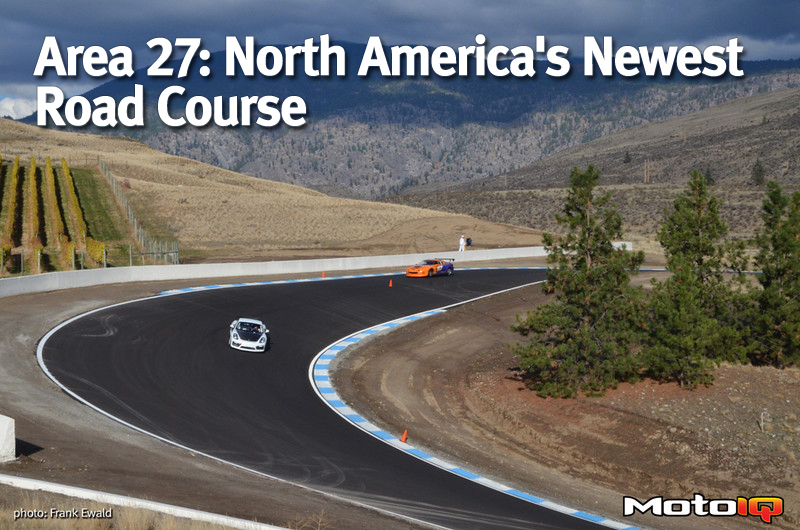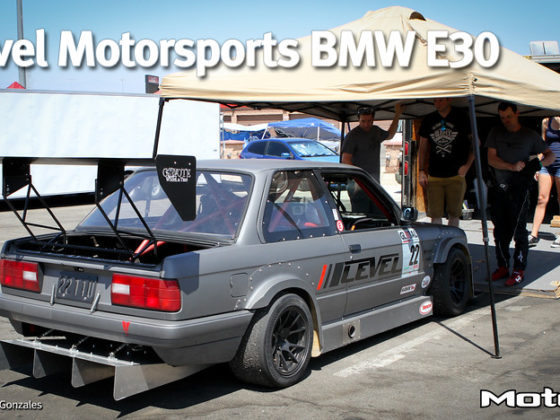,
 Bill approached Jacques Villeneuve (left) about designing the course and he was in from the beginning. Here they are on top of one of the nearby foothills, looking down upon what is now Turn 7 and the rest of the track. Bill and Jacques raced together in the mid-eighties, forming a friendship that now has them working together. Photo: Area 27
Bill approached Jacques Villeneuve (left) about designing the course and he was in from the beginning. Here they are on top of one of the nearby foothills, looking down upon what is now Turn 7 and the rest of the track. Bill and Jacques raced together in the mid-eighties, forming a friendship that now has them working together. Photo: Area 27As a teenager Bill had gone to Ontario and attended Richard Spenard's race school. He recognizes that era as being prime time for autosports as advertisers were spending big advertising dollars both at the track and off of the track to attract spectators. Spectators, of course, bring in big purses. The combination of sponsorship and spectators resulted in motorsports growth. Throughout his racing career, the idea of a track and race academy in western Canada was ruminating. While there were some small tracks, to experience a big track or attend a school meant heading East or down to the States. While the idea was not always at the forefront, it was there. So when Bill saw the plateau as he was returning from a ski trip to Mount Baldy – located just east of Oliver, B.C. – he started to see how he could make his dream a reality.
The plateau that was the focus of interest was located on First Nations land. A meeting with Chief Clarence Louie of the Osoyoos Indian Band led to a drive about the reserve. Chief Clarence is an astute businessman who has led the Osoyoos Indian Band into being one of the most profitable First Nation in Canada. He told Bill that the location, while good, was not the spot Bill wanted. After bumping along for a few more kilometres, Chief Clarence and Bill were looking at the corn field. Recognizing that a motorsport club would bring in a completely different clientel (for example, starting a new ski hill or a new golf club would compete for people already coming to the community, while a motorsport club would entice an entirely different pocket of the population), the Chief was supportive of the project. It was at this point that Bill contacted his friend, 1997 Formula 1 champion Jacques Villeneuve, about designing the track. Of course, Jacques was interested.
 Trevor Seibert, owner of Lake Excavating, has handled massive projects throughout his career. Area 27 not only captivated his enthusiasm from an engineering perspective but also from a racing perspective. Trevor is a very capable racer. Photo: Area 27
Trevor Seibert, owner of Lake Excavating, has handled massive projects throughout his career. Area 27 not only captivated his enthusiasm from an engineering perspective but also from a racing perspective. Trevor is a very capable racer. Photo: Area 27The second friend that Bill called was Trevor Seibert. Trevor is the president of Lake Excavating, based in British Columbia, and a significant contractor in Western Canada. Trevor is a racer. Indy Lights, NASCAR Canada, CASCAR, Formula Atlantic, Players GM/Camaro Challenge – Trevor absolutely has racing in his blood. Looking over racing statistics it does appear that Trevor may be been a bit faster than Bill on the track. I am going to have to sit down with both of them to ask that key question. Regardless of who was faster – Trevor, from Williams Lake, BC, signed on.
Then Bill called upon David King. David had the expertise in real estate that a challenging project like this required. He also had the heart for this project, being a racing enthusiast who has been a friend of the Drossos family for 30 or so years. He also rubbed tires with Jacques and Bill running F2000 cars in the 1980's at Shannonville Motorsports Park in Ontario. David's extensive involvement in the worldwide real estate market was crucial to getting this project to move beyond dreams and into reality. The crucial next steps that he pointed out were to get a Letter of Intent and then to get some seed money.
 Here we see the construction of Corner 14 to the mid-right and the perimeter road in the foreground. The heavy equipment used GPS technology, supported by old fashioned surveyors, but technology abounded in the creation of this track. Track simulations on R-Factor were used to assist in the design but also in the placement of run off areas and concrete walls. They literally tried to crash in every conceivable manner on the simulation – to ensure that they were building a safe track. Photo: Area 27
Here we see the construction of Corner 14 to the mid-right and the perimeter road in the foreground. The heavy equipment used GPS technology, supported by old fashioned surveyors, but technology abounded in the creation of this track. Track simulations on R-Factor were used to assist in the design but also in the placement of run off areas and concrete walls. They literally tried to crash in every conceivable manner on the simulation – to ensure that they were building a safe track. Photo: Area 27The connections and friendships that were formed in the 80s and 90s have come to fruition. The need for a track in Western Canada was obvious. Timing was everything and while the need was there in the eighties80s also, it obviously was not the time. Bill points out that modern sports cars are, right off of the showroom floor, faster than their old race cars. The choice of a country club model – which has proven successful in the United States – made a lot of sense. The four initial founders wanted to be sure that they were successful, so it was crafted in a way to ensure that it was. With the Letter of Intent the first membership drive began in 2013. Jacques came to the Okanagan and saw the site and then they met with interested parties – at a supercars' drivers dinner where Jacques was a featured guest – and began to sign up members. On-site preparation work was another key step.There were just over 100 members prior to paving. Upon the completion of paving – a massive step forward in the life of the complex – there are now 205 members.
 Paving through Turn 7 led to its own challenges. 7b has an 11° bank and that was too much of an angle for the dump trucks to unload the asphalt. As a result, front end loaders had to bring the material in. About 50% of the construction workforce came from the Osoyoos Indian Band. As the OIB has its own construction firm, working for Lake Excavating on this world class project was a great opportunity to learn new technology. Photo: Jeannette Montgomery
Paving through Turn 7 led to its own challenges. 7b has an 11° bank and that was too much of an angle for the dump trucks to unload the asphalt. As a result, front end loaders had to bring the material in. About 50% of the construction workforce came from the Osoyoos Indian Band. As the OIB has its own construction firm, working for Lake Excavating on this world class project was a great opportunity to learn new technology. Photo: Jeannette Montgomery Paving is a huge milestone – but before that the milestone was when the curbing was completed. The track is three miles long, 40 feet wide, and the asphalt is double layer and 4 inches thick. Notice the two pavers running staggered pattern. They're not racing, they're laying the best possible asphalt with no seams. That isn't possible on highway construction as entire roadways would have to be closed. Photo: Jeannette Montgomery
Paving is a huge milestone – but before that the milestone was when the curbing was completed. The track is three miles long, 40 feet wide, and the asphalt is double layer and 4 inches thick. Notice the two pavers running staggered pattern. They're not racing, they're laying the best possible asphalt with no seams. That isn't possible on highway construction as entire roadways would have to be closed. Photo: Jeannette Montgomery Ryley Seibert (Site Manager – left) with his dad Trevor Seibert. Ryley races against his dad in the NASCAR Canada series. Trevor designed Corner 7 with its awesome 11° slope. One construction advantage of the Area 27 site was that the majority of raw material was already here. The paving plant was even set up onsite. Photo: Jeannette Montgomery
Ryley Seibert (Site Manager – left) with his dad Trevor Seibert. Ryley races against his dad in the NASCAR Canada series. Trevor designed Corner 7 with its awesome 11° slope. One construction advantage of the Area 27 site was that the majority of raw material was already here. The paving plant was even set up onsite. Photo: Jeannette Montgomery


